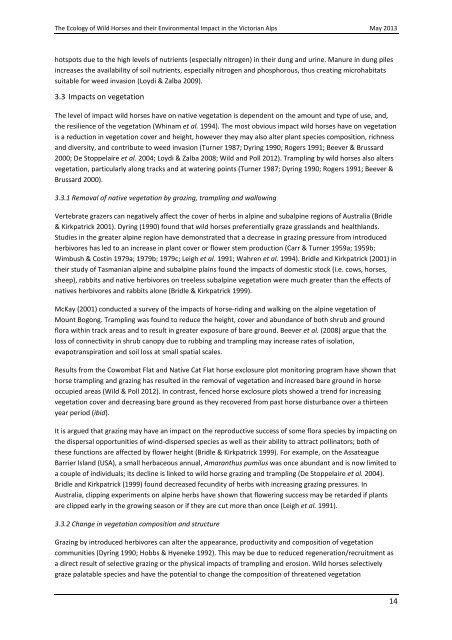The Ecology of Wild Horses and their Environmental ... - Parks Victoria
The Ecology of Wild Horses and their Environmental ... - Parks Victoria
The Ecology of Wild Horses and their Environmental ... - Parks Victoria
You also want an ePaper? Increase the reach of your titles
YUMPU automatically turns print PDFs into web optimized ePapers that Google loves.
<strong>The</strong> <strong>Ecology</strong> <strong>of</strong> <strong>Wild</strong> <strong>Horses</strong> <strong>and</strong> <strong>their</strong> <strong>Environmental</strong> Impact in the <strong>Victoria</strong>n Alps May 2013hotspots due to the high levels <strong>of</strong> nutrients (especially nitrogen) in <strong>their</strong> dung <strong>and</strong> urine. Manure in dung pilesincreases the availability <strong>of</strong> soil nutrients, especially nitrogen <strong>and</strong> phosphorous, thus creating microhabitatssuitable for weed invasion (Loydi & Zalba 2009).3.3 Impacts on vegetation<strong>The</strong> level <strong>of</strong> impact wild horses have on native vegetation is dependent on the amount <strong>and</strong> type <strong>of</strong> use, <strong>and</strong>,the resilience <strong>of</strong> the vegetation (Whinam et al. 1994). <strong>The</strong> most obvious impact wild horses have on vegetationis a reduction in vegetation cover <strong>and</strong> height, however they may also alter plant species composition, richness<strong>and</strong> diversity, <strong>and</strong> contribute to weed invasion (Turner 1987; Dyring 1990; Rogers 1991; Beever & Brussard2000; De Stoppelaire et al. 2004; Loydi & Zalba 2008; <strong>Wild</strong> <strong>and</strong> Poll 2012). Trampling by wild horses also altersvegetation, particularly along tracks <strong>and</strong> at watering points (Turner 1987; Dyring 1990; Rogers 1991; Beever &Brussard 2000).3.3.1 Removal <strong>of</strong> native vegetation by grazing, trampling <strong>and</strong> wallowingVertebrate grazers can negatively affect the cover <strong>of</strong> herbs in alpine <strong>and</strong> subalpine regions <strong>of</strong> Australia (Bridle& Kirkpatrick 2001). Dyring (1990) found that wild horses preferentially graze grassl<strong>and</strong>s <strong>and</strong> healthl<strong>and</strong>s.Studies in the greater alpine region have demonstrated that a decrease in grazing pressure from introducedherbivores has led to an increase in plant cover or flower stem production (Carr & Turner 1959a; 1959b;Wimbush & Costin 1979a; 1979b; 1979c; Leigh et al. 1991; Wahren et al. 1994). Bridle <strong>and</strong> Kirkpatrick (2001) in<strong>their</strong> study <strong>of</strong> Tasmanian alpine <strong>and</strong> subalpine plains found the impacts <strong>of</strong> domestic stock (i.e. cows, horses,sheep), rabbits <strong>and</strong> native herbivores on treeless subalpine vegetation were much greater than the effects <strong>of</strong>natives herbivores <strong>and</strong> rabbits alone (Bridle & Kirkpatrick 1999).McKay (2001) conducted a survey <strong>of</strong> the impacts <strong>of</strong> horse-riding <strong>and</strong> walking on the alpine vegetation <strong>of</strong>Mount Bogong. Trampling was found to reduce the height, cover <strong>and</strong> abundance <strong>of</strong> both shrub <strong>and</strong> groundflora within track areas <strong>and</strong> to result in greater exposure <strong>of</strong> bare ground. Beever et al. (2008) argue that theloss <strong>of</strong> connectivity in shrub canopy due to rubbing <strong>and</strong> trampling may increase rates <strong>of</strong> isolation,evapotranspiration <strong>and</strong> soil loss at small spatial scales.Results from the Cowombat Flat <strong>and</strong> Native Cat Flat horse exclosure plot monitoring program have shown thathorse trampling <strong>and</strong> grazing has resulted in the removal <strong>of</strong> vegetation <strong>and</strong> increased bare ground in horseoccupied areas (<strong>Wild</strong> & Poll 2012). In contrast, fenced horse exclosure plots showed a trend for increasingvegetation cover <strong>and</strong> decreasing bare ground as they recovered from past horse disturbance over a thirteenyear period (ibid).It is argued that grazing may have an impact on the reproductive success <strong>of</strong> some flora species by impacting onthe dispersal opportunities <strong>of</strong> wind-dispersed species as well as <strong>their</strong> ability to attract pollinators; both <strong>of</strong>these functions are affected by flower height (Bridle & Kirkpatrick 1999). For example, on the AssateagueBarrier Isl<strong>and</strong> (USA), a small herbaceous annual, Amaranthus pumilus was once abundant <strong>and</strong> is now limited toa couple <strong>of</strong> individuals; its decline is linked to wild horse grazing <strong>and</strong> trampling (De Stoppelaire et al. 2004).Bridle <strong>and</strong> Kirkpatrick (1999) found decreased fecundity <strong>of</strong> herbs with increasing grazing pressures. InAustralia, clipping experiments on alpine herbs have shown that flowering success may be retarded if plantsare clipped early in the growing season or if they are cut more than once (Leigh et al. 1991).3.3.2 Change in vegetation composition <strong>and</strong> structureGrazing by introduced herbivores can alter the appearance, productivity <strong>and</strong> composition <strong>of</strong> vegetationcommunities (Dyring 1990; Hobbs & Hyeneke 1992). This may be due to reduced regeneration/recruitment asa direct result <strong>of</strong> selective grazing or the physical impacts <strong>of</strong> trampling <strong>and</strong> erosion. <strong>Wild</strong> horses selectivelygraze palatable species <strong>and</strong> have the potential to change the composition <strong>of</strong> threatened vegetation14
















